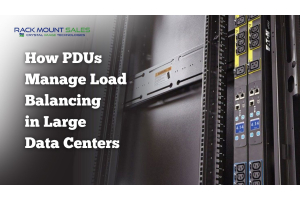Rack-mount v/s Wall Mount Rack: Which One is Ideal for You?
In today's digital age, technology infrastructure has become an integral part of businesses and organizations. And one of the most crucial components of any technological infrastructure is the rack on which it is mounted. Choosing the right type of rack is essential to ensure that your infrastructure is secure, functional, and optimized for your needs. Explore the benefits and find the perfect fit for your requirements, including the integration of a rackmount monitor.
Rack-Mount Racks
Rack-mount racks are the more traditional option of the two. They have been a popular choice for businesses and organizations for many years. These racks come in a wide range of sizes and are typically placed on the floor or mounted on a raised floor or platform. They are designed to accommodate high-performance hardware such as servers, switches, and other computing equipment that requires a significant amount of power.
Customizability
One of the most significant advantages of rack-mount racks is their high level of customizability. You can purchase racks in different heights, widths, and depths to meet your specific hardware requirements. Additionally, you can add shelves, drawers, and other accessories to the rack to create a customized infrastructure that meets your needs. This feature makes rack-mount racks highly adaptable and flexible, allowing businesses to create unique configurations that fit their specific needs.
Cooling Capacity
Another significant benefit of rack-mount racks is their excellent cooling capacity. Most racks come equipped with fans to help regulate the temperature of your hardware. Some models even have built-in cooling systems that are designed to help manage the heat generated by high-performance computing equipment like servers. This is particularly important for businesses that rely on their equipment to perform critical operations and require a high level of uptime.
Drawbacks
However, despite their many benefits, rack-mount racks do come with some downsides. For one, they are generally quite large and take up a considerable amount of space. This can be a problem for businesses that have limited space in their server room or data center. Furthermore, they are difficult to install and configure, especially for those who are not very familiar with the hardware and this can cause a problem. Due to this, installation and maintenance costs can be high, which can impact a business's budget.
Overall, rack-mount racks offer excellent performance, reliability, and customizability, making them a popular choice for businesses that require a high level of computing power. However, they may not be the best option for those with limited space or limited technical expertise, as they can be challenging to install and maintain.
Wall-Mount Racks
Wall-mount racks, on the other hand, are a newer option. Wall-mount racks are an increasingly popular option in recent years. As the name suggests, these racks are mounted on a wall rather than placed on the floor.
Size and Space
Wall-mount racks are generally smaller than their rack-mount counterparts and take up less space. This makes them a great option for smaller businesses or organizations with limited server room or data center space. If you have limited space but still need a secure place to mount your hardware, a wall-mount rack may be the ideal option for you.
Installation and Configuration: Simple and Easy
Installation and configuration of wall-mount racks are generally easier than rack-mount racks. They can be installed quickly and easily by one or two people, and their small size makes them easier to handle. Compared to rack-mount racks, wall-mount racks require less technical expertise, which is why they are often the preferred option for smaller businesses with limited IT staff. Installing a wall-mount rack can save you both time and money.
Cooling Capacity: A Potential Drawback
A potential drawback of wall-mount racks is that they may not have the same cooling capacity as rack-mount racks. While they are generally equipped with fans, they may not have built-in cooling systems like rack-mount racks. This means that if you are having hardware or systems that produces a lot of heat, a wall-mount rack may not be the ideal option for you. Cooling is an important consideration when selecting the right type of rack, so it is important to take this into account when making your decision.
Customization: Fewer Options Available
Wall-mount racks may not be as customizable as rack-mount racks. They come in fixed sizes and may not have as many accessories available for customization. If you have specific hardware requirements that require customization, a rack-mount rack may be the better option for you. Rack-mount racks come in a wide variety of sizes and can be fitted with shelves, drawers, and other accessories to meet your specific hardware needs. If customization is a priority for you, a rack-mount rack may be the way to go.
Factors to Consider
When deciding whether a rack-mount or wall-mount rack is ideal for you, there are several factors to consider. These include space requirements, hardware requirements, cooling needs, and ease of installation. Let’s discuss these factors,
Space Requirements
Space requirement is a crucial factor to consider. You need to consider the amount of space you have available for your server room or data center before choosing between the two. If you have limited space, a wall-mount rack may be the better option.
Hardware Requirements
Another significant factor you need to consider is the type and number of hardware you need to mount on the rack. Rack-mount racks may be better suited for larger, high-performance hardware such as servers and switches, while wall-mount racks may be better suited for smaller hardware such as routers and modems.
Cooling Needs
The cooling requirements of your hardware are also essential. If you have hardware that produces a lot of heat, a rack-mount rack with built-in cooling systems may be a better option.
Ease of Installation
If you're not familiar with hardware installation, a wall-mount rack may be a better option, as it's generally easier to install and configure.
Conclusion
Choosing the right type of rack is crucial for ensuring that your technology infrastructure is secure, functional, and optimized for your needs. Whether you choose a rack-mount or wall-mount rack will depend on several factors, including space requirements, hardware requirements, cooling needs, and ease of installation.
Rackmount racks are the more traditional option and are highly customizable. They come in various sizes and can be fitted with shelves and other accessories to meet your specific hardware requirements. They also have built-in cooling systems that help regulate the temperature of your hardware. However, they take up a lot of space and may be challenging to install and configure.
On the other hand, wall-mount racks are a newer option and take up less space than rack-mount racks. They're easy to install and configure and are a great option for businesses with limited space. However, they may not have the same cooling capacity as rack-mount racks and customization options may be limited.
Ultimately, the decision to choose a rack-mount or wall-mount rack will depend on your specific needs and requirements. By considering the factors discussed in this article you can decide which option suits you best, and you'll be sure to choose a rack that's ideal for your needs.











